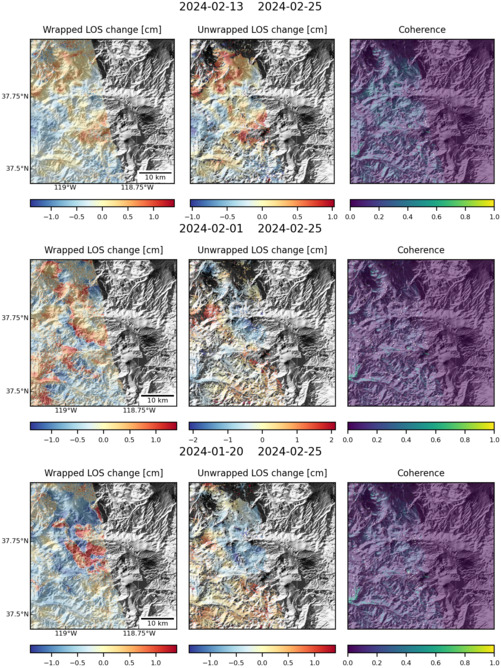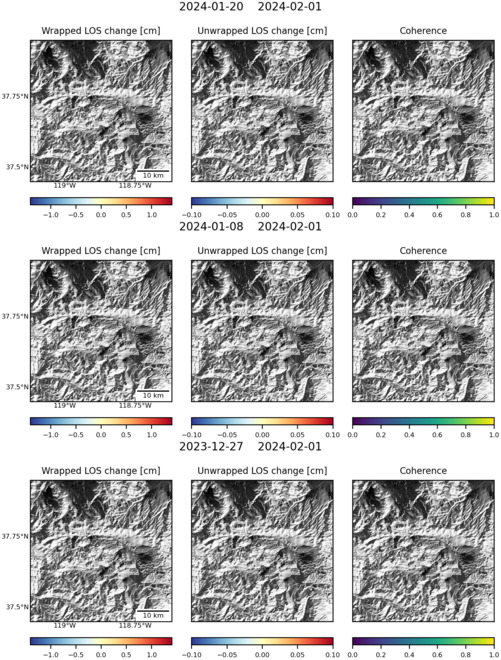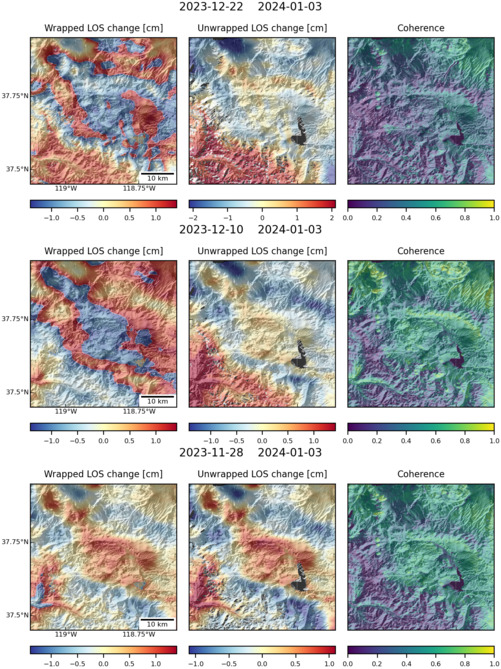Observations of Deformation
| Volcano number: | 323822 |
|---|---|
| Region: | Canada and Western USA |
| Country: | United States |
| Geodetic measurements? | Yes |
| Deformation observation? | Yes |
| Measurement method(s): | InSAR, GPS - continuous, Levelling, Tiltmeter, EDM, Gravity |
| Duration of observation: | 1975 - present |
| Inferred cause(s) of deformation: | Hydrothermal, Magmatic |
| Characteristics of deformation: | In the last ~35 years, over 75 cm of uplift has been observed at Long Valley Caldera at an average rate of 3 cm/yr. Deformation within the caldera is dominated by episodic, symmetrical inflation of the resurgent dome, with no periods of subsidence. Uplift occurred in 1978-1983, 1990-1995, 1996, and 1997-1998. This ground deformation has been monitored using an array of ground based instruments including 46 GPS receivers and 9 tiltmeters that make up the network monitoring Long Valley Caldera (http://earthquake.usgs.gov/monitoring/gps/LongValley/). Tiltmeters were installed in the early 1980s, with additional instruments added in 2009. The first GPS receiver was installed in 1995, with the network then being updated and modernised between 2006 and 2008. More recently deformation measurements have been made using InSAR. Gravity surveys reveal a positive anomaly centered on the resurgent dome with peak amplitude of 66 ± 11 μGal. Best fitting source models vary between studies: most of the deformation field can be explained by a spatially compact inflation source in the form of a near-vertical, pipe-like, prolate ellipsoid, but can be equally well fitted by a spatially distributed inflation source. However, all datasets suggest that the source is located beneath the resurgent dome at depths 5 – 8 km. The 1978–2004 unrest is associated with the addition of ~0.3 km³ of material (probably a combination of magma and hydrous fluids) into the brittle crust from the subjacent magma body at a depth of 6 – 7 km beneath the resurgent dome. Gravity results indicate a mass increase beneath the resurgent dome with a density in the range 1180 to 2330 kg m−3. |
| Reference(s): | U.S. Geological Survey California Volcano Observatory (CalVO) https://volcanoes.usgs.gov/volcanoes/long_valley/long_valley_monitoring_1.html |
| Tizzani, P., Battaglia, M., Zeni, G., Atzori, S., Berardino, P., & Lanari, R. (2009). Uplift and magma intrusion at Long Valley caldera from InSAR and gravity measurements. Geology, 37(1), 63-66. | |
| Battaglia, M., & Vasco, D. W. (2006). The search for magma reservoirs in Long Valley Caldera: single versus distributed sources. Geological Society, London, Special Publications, 269(1), 173-180. | |
| Hill, D. P. (2006). Unrest in Long Valley Caldera, California, 1978–2004. Troise, C., De Natale, G. & Kilburn, C. R. (Eds.) , Mechanisms of Activity and Unrest at Large Calderas , 269, 1-24 pp. http://www.geolsoc.org.uk/gsl/publications/bookshop/page1251.html | |
| Newman, A. V., Dixon, T. H., & Gourmelen, N. (2006). A four-dimensional viscoelastic deformation model for Long Valley Caldera, California, between 1995 and 2000. Journal of volcanology and geothermal research, 150(1), 244-269. | |
| Location: | 37.7, -118.87 |
| REST API endpoint (JSON): | https://comet.nerc.ac.uk/wp-json/volcanodb/v1/volcano/1224 |
Latest Sentinel-1 Data

Size: 501px x 668px (171.82 KB)

Size: 501px x 660px (152.70 KB)

Size: 501px x 669px (176.22 KB)
